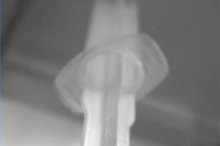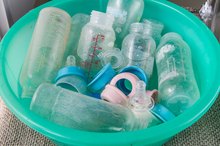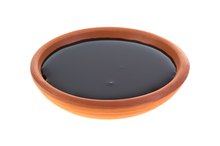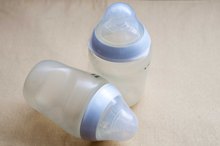How to Unclog a Syringe
Syringes are used in a variety of ways for both human and animal health care. Many of the larger 60cc syringes are used to give food laced with medicine to children or animals. This can cause stubborn clogs in the syringe that are hard to remove. Syringes that have contained food are prone to accumulating bacteria so should always be cleaned and disinfected thoroughly. To keep clogs from occurring, always wash the syringe out with hot water immediately after using.
Remove the needle from the syringe -- if one is attached -- and dispose of it properly in a sharps or hazardous waste receptacle.
How to Carry Lunch Food in a Thermos
Learn More
Remove the plunger from the syringe, so that you have two separate parts.
Soak the syringe cylinder and the plunger in a sink full of hot soapy water for approximately 30 minutes.
How to Clean a Feeding Tube
Learn More
Put the plunger back into the syringe and pull backward to fill the syringe with hot soapy water. Push down on the plunger to force the hot soapy water back out of the syringe.
Insert a toothpick, or small needle for small syringes, into the needle end of the syringe to unclog stubborn blockages.
Scrub the inside of the syringe with a small baby bottle scrubber or toothbrush, to get deposits off the sides of the syringe, such as dried food.
Rinse both pieces of the syringe thoroughly with hot water.
Tip the syringe sideways in a bowl lined with paper towels. This will allow the water to drain completely from the tip of the syringe.
Allow both pieces of the syringe to air dry completely.
Reinsert the plunger into the syringe and store it in a clean dry space 1.
Tips
Always reinsert the plunger once the pieces are dry; otherwise oxidation on the rubber tip of the plunger will cause the plunger to not fit back into the syringe.
Warnings
Never use a dirty syringe to give medications or food.
Syringes that are not properly air dried can accumulate bacteria.
Related Articles
References
- State of New Hampshire State of New Hampshire Department of Health and Human Services Division of Community-based Care Services Division of Community-based Care Services Bureau of Developmental Services. Medication Administration Curriculum.; Section II. 2012. dhhs.nh.gov
- Guy JS. Pharmacology for the Prehospital Professional. Second. Jones & Bartlett Learning; 2019:82.
- WHO Best Practices for Injections and Related Procedures Toolkit. Geneva: World Health Organization; 2010 Mar. 2, Best practices for injection. Available from: https://www.ncbi.nlm.nih.gov/books/NBK138495/
- Gill HS, Prausnitz MR. Does Needle Size Matter? J Diabetes Sci Technol. 2007;1(5):725-729. doi:10.1177/193229680700100517
- Weiss M, Hug MI, Neff T, Fischer J. Syringe size and flow rate affect drug delivery from syringe pumps. Can J Anesth. 2000;47(10):1031-1035. doi:10.1007/BF03024878
- Hamborsky J, Kroger A, Wolfe S, eds. Centers for Disease Control and Prevention. Epidemiology and Prevention of Vaccine-Preventable Diseases. Chapter 6: Vaccine Administration. 13th edition. Washington, DC; Public Health Foundation, 2015.
- Salari M, Estaji Z, Akrami R, Rad M. Comparison of skin traction, pressure, and rapid muscle release with conventional method on intramuscular injection pain: A randomized clinical trial. J Educ Health Promot. 2018;7:172. Published 2018 Dec 28. doi:10.4103/jehp.jehp_216_18
- Centers for Disease Control and Prevention. Vaccine Recommendations and Guidelines of the ACIP: Vaccine Administration. Updated June 21, 2019.
- Doyle, G.R., McCutcheon, J.A. (2015). Clinical Procedures for Safer Patient Care. Chapter 7.3: Intradermal and Subcutaneous Injections. Victoria, BC: BCcampus.
- Doyle, G.R., McCutcheon, J.A. (2015). Clinical Procedures for Safer Patient Care. Chapter 7.4: Intramuscular Injections. Victoria, BC: BCcampus.
- Grissinger M. Reducing errors with injectable medications: unlabeled syringes are surprisingly common. P T. 2010;35(8):428–451.
- Shemesh E,D'Urso C,Knight C et al. Food-Allergic Adolescents at Risk for Anaphylaxis: A Randomized Controlled Study of SupervisedInjectionto Improve Comfort with EpinephrineSelf-Injection. J Allergy Clin Immunol Pract.2017 Mar - Apr;5(2):391-397.e4. doi:10.1016/j.jaip.2016.12.016. Epub 2017 Jan 20.
- World Health Organization. WHO Best Practices for Injections and Related Procedures Toolkit-Best practices for injection. Geneva. March 2010.
Tips
- Always reinsert the plunger once the pieces are dry; otherwise oxidation on the rubber tip of the plunger will cause the plunger to not fit back into the syringe.
Warnings
- Never use a dirty syringe to give medications or food.
- Syringes that are not properly air dried can accumulate bacteria.
Writer Bio
Kay Baxter is a freelance writer that has been writing articles since 1999 on a variety of subjects such as small equine and art instruction. Her book "Miniature Horse Conformation" was published in 2007. Baxter has also had articles published by "Better Homes & Garden" and "The Horse Magazine." Baxter attended Illinois Central College, majoring in art.









